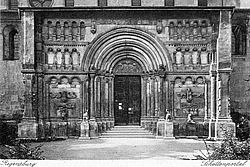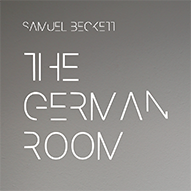English
Beckett spent two days and two nights in Regensburg. He arrived on the evening of 02/03/37 from Nuremberg and on 04/03/37, sometime after 4 pm, took the train to Munich. His stay was devoted to walking the city and visiting its sights, especially its most famous churches. In the sculptures of the Dom St. Peter, the Steinerne Brücke, the Jakobskirche or the Basilika St. Emmeram, he found much to engage both his interest in medieval art and his penchant for interrogating the elusive inner lives of the characters, painted or carved in stone, that he studied. The Celtic influences traceable in the iconography of the Schottentor occupied him enough that he wrote to Thomas MacGreevy to ask – using many of the same words as in the diary – if he could help decipher it (letter of 04/03/37); and the figures of the Verkündigungsgruppe sparked speculation about Mary’s thoughts in the very moment of the Annunciation.
On his second day, Beckett took the tram from Bismarckplatz to Prüfening, where he went to see the tomb of Abbot Erminold in the secularised Benedictine abbey. Crafted by the same sculptor as the Annunciation, the Erminoldmeister, the tomb to Beckett somewhat paled in comparison to the statuary of St. Peter Cathedral, but his characteristically meticulous observation led him to still appreciate details such as the abbot’s gloved hand, his fine nose, and the “[w]onderful crushed cushion under head”.
Another character that captured Beckett’s imagination in Regensburg was the Danube River. He walked along its banks several times and crossed to Stadtamhof to contemplate its confluence with the Regen, which led him, four days later in Munich after looking at the “piddle” of the Isar, to write to MacGreevy of the “heroic Danube in Regensburg” (letter of 07/03/37). But the impressions of his walk, the river and “the mingling” stayed with him far longer: Over four decades later, he would write of it again in Ohio Impromptu.
Day after day he could be seen slowly pacing the islet. Hour after hour. In his long black coat no matter what the weather and old world Latin Quarter hat. At the tip he would always pause to dwell on the receding stream. How in joyous eddies its two arms conflowed and flowed united on. Then turn and his slow steps retrace.
(Ohio Impromptu)
Dom St. Peter (Display Case #1)
03/03/37
But facing each other across nave from crossing pillars, smiling across at each other, a superb Annunciation by the Erminoldmeister (late 13th century), so called from tomb figure of Abbot Erminold in the Benedictine Cloister Church in Prüfening, a couple of miles W. from Regensburg, where perhaps I may get to to-morrow. Am not sure at first which is which. Both beaming & Virgin holding up a lovely right hand. But the book gives her away. Angels don’t have books. Affinities with the Dionysus angel in Bamberg. And yet not. More lyrical. Angel with delighted look of an express messenger from Irish Hospitals Trust, Mary […] incredulous, flattered, happy, astonished as though by someone bursting in without knocking & interrupting her reading, all written on a surface of doom only to an eye of such permanent biliosity as mine. She has not had time to think it over. Has Gabriel spoken? Does she take him merely – merely! – for an admirer. And so on.
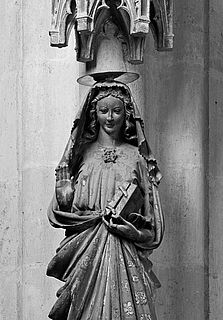 | 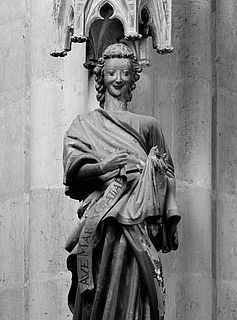 |
Erminoldmeister, Mary and the Angel Gabriel, Verkündigungsgruppe (13th century)
© Domkapitel Regensburg | Foto: Florian Monheim
“floating bridge” (Display Case #2)
On 03/03/37, Beckett walked across the Steinerne Brücke and then eastward to the bank of what, prior to the construction of the Europakanal in the 1970s, was still the River Regen. Just north of the confluence of Regen and Danube, a pontoon bridge, or floating bridge, connected Stadtamhof to Weichs. The Weichser Steg was privately operated by the Seidl family and cost 5 Pfennige to cross.
© Stadt Regensburg, Bilddokumentation
Jakobskirche, Schottentor (Display Case #3)
© Stadt Regensburg, Bilddokumentation
03/03/37
Irish (not Scottish) monks settled here in 11th century […]. So I search for Keltic motivs! A snake! And the shamrock that is never absent & signifies nothing. Innumerable interpretations: as Pronouncement of Evangile; as integration of humanity with God (Endres), with connexions with song of songs; as passing away of heaven & earth (Wiebel) […]. Completely different world from 13th century in Naumburg & Bamberg. In its naiveness (formal) & freedom from naturalism more modern. I know it is wrong to be concerned with what it means, but when one knows one is wrong it is diverting. Walk away past Dominikanerkirche, that I don’t look at, except to see on N. door notice Grüss Gott crossed out & replaced by Heil Hitler!!!
Tram / Straßenbahn (Display Case #4)
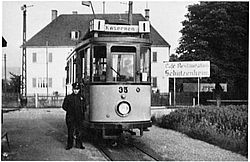 The historic Regensburg tram at the terminus in Prüfening (1938)
The historic Regensburg tram at the terminus in Prüfening (1938)
Historische Straßenbahn Regensburg e.V. | from the collection of Günther Schieferl
Postcard(s)
03/03/37 – Buy postcards of the door & the Annunciation in Dom.
Throughout his journey, Beckett kept up correspondences with a number of friends and family, including the Irish poet and critic Thomas MacGreevy, the bookseller’s assistant Günter Albrecht, whom Beckett had met in Hamburg, his aunt Frances (Cissie) Sinclair, and his mother May.
04/03/37 – Cards in PO to mother & Cissie.
The postcard of “the Annunciation in Dom” that he purchased at the Dombuchhandlung was not posted from Regensburg, though. Beckett kept it for over thirty years and sent it, in March 1969, to the French writer Danielle Collobert.
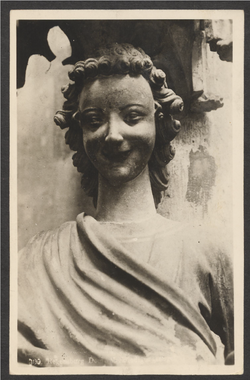 Postcard from Samuel Beckett to Danielle Collobert, 12/03/69
Postcard from Samuel Beckett to Danielle Collobert, 12/03/69
Regensburg University Library, 228/AM 96400 B396-6
Books
03/03/37
I ask for Georg Trakl, [refuse?] the complete works & buy him in the Insel Verlag. Buy also the Woerl Regensburg, the only alternative being obviously even worse. […] Find myself back in Neupfarrmkt. Go to Dom Buchhandlung & ask have they anything on the Schottentor. They produce Wiebel’s work, which I buy. Look again at the Zahn (2 RM antiquarisch), it seems good, but I would have no time to use it. Buy postcards of the door & the Annunciation in Dom.
04/03/37
Then wander by Weisse Hahnengasse, having bought Zahn on Dom in Dombuchhandlung […].
Although the visual arts were at the heart of Beckett’s Bildungsreise, they were not his only intellectual pursuit or pastime. He also went to concerts, the theatre and the cinema – and he spent much time buying and reading books. As meticulously as they chronicle art, the Diaries also record the books that were lent and recommended to Beckett, that he bought and read, discussed with others and thought about.
Shown in the display case are the Baedeker travel guide that Beckett purchased in Hamburg on 09/10/36, as well as the four volumes he purchased from Regensburg bookshops: Richard Wiebel‘s Das Schottentor (1927), Karl Zahn‘s Der Dom zu Regensburg (1929), Gesang des Abgeschiedenen: Gedichte (1933) by Georg Trakl, and the Woerl guide Illustrierter Führer durch Regensburg und Umgebung (1931), of which a facsimile is available for perusal.
Deutsch
Beckett verbrachte zwei Tage und Nächte in Regensburg. Er kam am Abend des 02/03/37 aus Nürnberg an und nahm am 04/03/37 nach 16 Uhr einen Zug nach München. Sein Aufenthalt war der Erkundung der Stadt und ihrer Sehenswürdigkeiten, besonders ihrer bekanntesten Kirchen, gewidmet. In den Skulpturen des Doms St. Peter, der Steinernen Brücke oder der Basilika St. Emmeram fand er viel Futter sowohl für sein Interesse an mittelalterlicher Kunst und seine Neigung dazu, nachzudenken über das geheimnisvolle innere Wesen der Figuren, gemalt oder in Stein gemeißelt, die er studierte. Die keltischen Einflüsse, die in der Ikonografie des Schottentors zu finden sind, beschäftigten Beckett genug, dass er an Thomas MacGreevey schrieb, um – in vielen derselben Worte wie im Tagebuch – zu fragen, ob er dabei helfen könne, diese Einflüsse zu entschlüsseln (Brief vom 04/03/37); und die Figuren der Verkündigungsgruppe veranlassten ihn dazu, über die Gedanken der Hl. Maria im Moment der Verkündigung nachzudenken.
An seinem zweiten Tag nahm Beckett die Straßenbahn vom Bismarckplatz nach Prüfening, wo er das Grab des Benediktinerabts Erminold im säkularisierten Kloster besuchte. Das Grab, wie die Verkündigungsgruppe eine Schöpfung des Erminoldmeisters, verblasse für Beckett im Vergleich zu den Plastikgen des Regensburger Doms, aber seine stets akribische Beobachtungsgabe erlaubte es ihm dennoch, einige schätzenswerte Details zu erkennen: so beispielsweise die behandschuhte Hand des Abts, seine fein gearbeitete Nase und „[w]onderful crushed cushion under head.“
Eine weitere Regensburger Figur, die Beckett faszinierte, war die Donau. Er spazierte mehrere Male am Ufer entlang und überquerte die Steinerne Brücke nach Stadtamhof, um ihr Zusammentreffen mit dem Regen zu betrachten, welches ihn dazu bewegte, MacGreevy von der „heroic Danube in Regensburg“ (Brief vom 07/03/37) zu schreiben, nachdem er vier Tage später in München einen Blick auf die „piddle of the Isar“ geworfen hatte. Die Eindrücke dieses Spaziergangs, der Donau und es Zusammenflusses begleiteten ihn aber noch viel länger: Über vier Jahrzehnte später würde er in Ohio Impromptu wieder davon schreiben.
Day after day he could be seen slowly pacing the islet. Hour after hour. In his long black coat no matter what the weather and old world Latin Quarter hat. At the tip he would always pause to dwell on the receding stream. How in joyous eddies its two arms conflowed and flowed united on. Then turn and his slow steps retrace.
(Ohio Impromptu)
Dom St. Peter (Vitrine #1)
03/03/37
But facing each other across nave from crossing pillars, smiling across at each other, a superb Annunciation by the Erminoldmeister (late 13th century), so called from tomb figure of Abbot Erminold in the Benedictine Cloister Church in Prüfening, a couple of miles W. from Regensburg, where perhaps I may get to to-morrow. Am not sure at first which is which. Both beaming & Virgin holding up a lovely right hand. But the book gives her away. Angels don’t have books. Affinities with the Dionysus angel in Bamberg. And yet not. More lyrical. Angel with delighted look of an express messenger from Irish Hospitals Trust, Mary […] incredulous, flattered, happy, astonished as though by someone bursting in without knocking & interrupting her reading, all written on a surface of doom only to an eye of such permanent biliosity as mine. She has not had time to think it over. Has Gabriel spoken? Does she take him merely – merely! – for an admirer. And so on.
 |  |
Erminoldmeister, Mary and the Angel Gabriel, Verkündigungsgruppe (13th century)
© Domkapitel Regensburg | Foto: Florian Monheim
„floating bridge“ / Schwimmbrücke (Vitrine #2)
Am 03/03/37 überquerte Beckett die Steinerne Brücke und spazierte dann Richtung Osten zum Ufer das, bis zum Bau des Europakanals in den 1970ern, noch zum Regen gehörte. Knapp nördlich der Mündung des Regen in die Donau verband eine Ponton- oder Schwimmbrücke („floating bridge“) Stadtamhof mit Weichs. Der Weichser Steg wurde von der Familie Seidl privat betrieben. Eine Überquerung kostete 5 Pfennige.
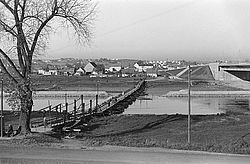 Weichser Steg (1937)
Weichser Steg (1937)
© Stadt Regensburg, Bilddokumentation
Jakobskirche, Schottentor (Vitrine #3)
© Stadt Regensburg, Bilddokumentation
Irish (not Scottish) monks settled here in 11th century […]. So I search for Keltic motivs! A snake! And the shamrock that is never absent & signifies nothing. Innumerable interpretations: as Pronouncement of Evangile; as integration of humanity with God (Endres), with connexions with song of songs; as passing away of heaven & earth (Wiebel) […]. Completely different world from 13th century in Naumburg & Bamberg. In its naiveness (formal) & freedom from naturalism more modern. I know it is wrong to be concerned with what it means, but when one knows one is wrong it is diverting. Walk away past Dominikanerkirche, that I don’t look at, except to see on N. door notice Grüss Gott crossed out & replaced by Heil Hitler!!!
Tram / Straßenbahn (Vitrine #4)
 Die historische Straßenbahn Regensburg auf dem Terminus in Prüfening (1938)
Die historische Straßenbahn Regensburg auf dem Terminus in Prüfening (1938)
Historische Straßenbahn Regensburg e.V. | aus der Sammlung von Günther Schieferl
Postkarte(n)
03/03/37 – Buy postcards of the door & the Annunciation in Dom.
Während seiner gesamten Reise unterhielt Beckett Korrespondenzen mit Freunden und Familie, darunter der irische Dichter und Kritiker Thomas MacGreevey, der Buchhändler Günter Albrecht, den Beckett in Hamburg kennengelernt hatte, seine Tante Frances (Cissie) Sinclair und seine Mutter May.
04/03/37 – Cards in PO to mother & Cissie.
Die Postkarte von der ‚Verkündigung im Dom‘ („the Annunciation in Dom“), die er in der Dombuchhandlung kaufte, versandte er jedoch nicht von Regensburg aus. Beckett behielt sie über dreißig Jahre lang und schicke sie im März 1969 an die französische Schriftstellering Danielle Collobert.
 Postkarte von Samuel Beckett an Danielle Collobert, 12/03/69
Postkarte von Samuel Beckett an Danielle Collobert, 12/03/69
UB Regensburg, 228/AM 96400 B396-6
Bücher
03/03/37
I ask for Georg Trakl, [refuse?] the complete works & buy him in the Insel Verlag. Buy also the Woerl Regensburg, the only alternative being obviously even worse. […] Find myself back in Neupfarrmkt. Go to Dom Buchhandlung & ask have they anything on the Schottentor. They produce Wiebel’s work, which I buy. Look again at the Zahn (2 RM antiquarisch), it seems good, but I would have no time to use it. Buy postcards of the door & the Annunciation in Dom.
04/03/37
Then wander by Weisse Hahnengasse, having bought Zahn on Dom in Dombuchhandlung […].
Obwohl die bildenden Künste das Herzstück von Becketts Bildungsreise darstellten, waren sie dennoch nicht seine einzige intellektuelle Beschäftigung. Er besuchte auch Konzerte, ging ins Theater und das Kino – und er verbrachte viel Zeit damit, Bücher zu kaufen und zu lesen. Ebenso detailliert wie Becketts Begegnungen mit Kunst, zeichnen die German Diaries auch auf, welche Bücher ihm geliehen oder empfohlen wurden, welche er erstand, las und mit Bekanntschaften besprach und was er über das Gelesene und Gesagte dachte.
Ausgestellt sind der Baedeker Reiseführer, den Beckett am 09/10/36 in Hamburg kaufte sowie vier Bücher, die er in Regensburger Buchhandlungen erstand: Richard Wiebels Das Schottentor (1927), Karl Zahns Der Dom zu Regensburg (1929), Gesang des Abgeschiedenen: Gedichte (1933) von Georg Trakl und den Illustrierten Führer durch Regensburg und Umgebung (1931) des Verlags Woerl, der als Faksimile zur Ansicht ausliegt.



